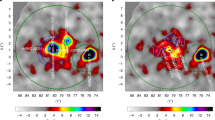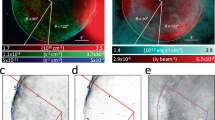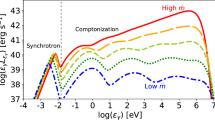Abstract
The origin of Galactic cosmic-ray ions has remained an enigma for almost a century. Although it has generally been thought that they are accelerated in the shock waves associated with powerful supernova explosions—for which there have been recent claims of evidence—the mystery is far from resolved. In fact, we may be on the wrong track altogether in looking for isolated regions of cosmic-ray acceleration.
This is a preview of subscription content, access via your institution
Access options
Subscribe to this journal
Receive 51 print issues and online access
$199.00 per year
only $3.90 per issue
Buy this article
- Purchase on Springer Link
- Instant access to full article PDF
Prices may be subject to local taxes which are calculated during checkout

Similar content being viewed by others
References
Shklovskii, I. S. On the origin of cosmic rays. Dokl. Akad. Nauk SSSR 91, 475–478 (1953)
Berezhko, E. G. & Volk, H. Theory of cosmic ray production in the supernova remnant RX J1713.7-3946. Astron. Astrophys. 451, 981–990 (2006)
Katz, B. & Waxman, E. In which shell-type SNRs should we look for gamma-rays and neutrinos from P–P collisions? J. Cosmol. Astropart. Phys. 01(2008)018 (2008)
Erlykin, A. D. & Wolfendale, A. W. The origin of cosmic rays. J. Phys. G 31, 1475–1498 (2005)
Butt, Y. et al. X-ray hotspot flares and implications for cosmic ray acceleration and magnetic field amplification in supernova remnants. Mon. Not. R. Astron. Soc. 386, L20–L22 (2008)
Liu, S. et al. Stochastic electron acceleration in shell-type supernova remnants. Astrophys. J. 683, L163–L166 (2008)
Warren, J. et al. Cosmic-ray acceleration at the forward shock in Tycho’s supernova remnant: evidence from Chandra X-ray observations. Astrophys. J. 634, 376–389 (2005)
Völk, H. J., Berezhko, E. G. & Ksenofontov, L. T. Internal dynamics and particle acceleration in Tycho’s SNR. Astron. Astrophys. 483, 529–535 (2008)
Hughes, J. P., Rakowski, C. E. & Decourchelle, A. Electron heating and cosmic rays at a supernova shock from Chandra X-ray observations of 1E 0102.2-7219. Astrophys. J. 543, L61–L65 (2000)
Helder, E. A. et al. Measuring the cosmic ray acceleration efficiency of a supernova remnant. Science 10.1126/science.1173383 (25 June 2009)
Albert, J. et al. Discovery of very high energy gamma radiation from IC 443 with the MAGIC telescope. Astrophys. J. 664, L87–L90 (2007)
Acciari, V. A. et al. (VERITAS collaboration). Observation of extended vhe emission from the supernova remnant IC 443 with VERITAS, Astrophys . J. Lett (in the press)
Aharonian, F. et al. Discovery of very high energy gamma-ray emission coincident with molecular clouds in the W 28 (G6.4–0.1) field. Astron. Astrophys. 481, 401–410 (2008)
Tian, W. et al. VLA and XMM-Newton observations of the SNR W41/TeV gamma-ray source HESS J1834–087. Astrophys. J. 657, L25–L28 (2007)
Tian, W. et al. Discovery of the radio and X-ray counterpart of TeV γ-ray source HESS J1731–347. Astrophys. J. 679, L85–L88 (2008)
Torres, D. F. et al. MAGIC J0616+225 as delayed TeV emission of cosmic rays diffusing from the supernova remnant IC 443. Mon. Not. R. Astron. Soc. 387, L59–L63 (2008)
Zhang, L. & Fang, J. Nonthermal emission from a radio-bright shell-type supernova remnant IC 443. Astrophys. J. 675, L21–L24 (2008)
Bartko, H. & Bernarek, W. γ-ray emission from PWNe interacting with molecular clouds. Mon. Not. R. Astron. Soc. 385, 1105–1109 (2008)
Gaisser, T. et al. Gamma-ray production in supernova remnants. Astrophys. J. 492, 219–227 (1998)
Yamazaki, R. et al. TeV γ-rays from old supernova remnants. Mon. Not. R. Astron. Soc. 371, 1975–1982 (2006)
Colgate, S. & Li, H. in The Role of Neutrinos, Strings, Gravity, and Variable Cosmological Constant in Elementary Particle Physics (eds Kursunoglu, B. N., Mintz, S. L. & Perlmutter, A.) 149–155 (Kluwer Academic, 2001)This manuscript presents some speculative, although truly novel and original, ideas regarding cosmic-ray acceleration.
Strong, A. W., Moskalenko, I. V. & Ptuskin, V. S. Cosmic-ray propagation and interactions in the Galaxy. Annu. Rev. Nucl. Part. Syst. 57, 285–327 (2007)
Ellison, D. C., Berezhko, E. G. & Baring, M. G. Nonlinear shock acceleration and photon emission in supernova remnants. Astrophys. J. 540, 292–307 (2000)
Krimigis, S. M. Voyager energetic particle observations at interplanetary shocks and upstream of planetary bow shocks – 1977–1990. Space Sci. Rev. 59, 167–201 (1992)
Fisk, L. A. & Gloeckler, G. Thermodynamic constraints on stochastic acceleration in compressional turbulence. Proc. Natl Acad. Sci. USA 104, 5749–5754 (2007)
Duric, N. The origin of cosmic rays in spiral galaxies. Space Sci. Rev. 48, 73–111 (1988)
Wiedenbeck, M. E. et al. Constraints on the time delay between nucleosynthesis and cosmic-ray acceleration from observations of 59Ni and 59Co. Astrophys. J. 523, L61–L64 (1999)
Wiedenbeck, M. et al. in Proc. 28th Int. Cosmic Ray Conf. (eds Kajita, T., Asaoka, Y., Kawachi, A., Matsubara, Y. & Sasaki, M.) 1899–1902 (Universal Academy, 2003)
Binns, W. R. et al. OB associations, Wolf Rayet stars, and the origin of Galactic cosmic rays. Space Sci. Rev. 130, 439–449 (2007)This paper presents arguments for superbubbles having a significant role in Galactic cosmic-ray acceleration, on the basis of the composition of cosmic rays.
Parizot, E., Paul, J. & Bykov, A. M. in Proc. 27th Int. Cosmic Ray Conf. 2070–2073 (Copernicus Gesellschaft, 2001)Many of the hidden assumptions that have perpetuated the myth that cosmic rays most likely originate in isolated supernova remnants are outlined in this work.
Seo, E. S. & Ptuskin, V. S. Stochastic reacceleration of cosmic rays in the interstellar medium. Astrophys. J. 431, 705–714 (1994)
Hillas, M. J. Can diffusive shock acceleration in supernova remnants account for high-energy galactic cosmic rays? J. Phys. G 31, R95–R131 (2005)
Medina-Tanco, G. A. & Opher, R. Spatial and temporal distributed acceleration of cosmic rays by supernova remnants three-dimensional simulations. Astrophys. J. 411, 690–707 (1993)This study suggests that distributed Galaxy-wide acceleration could be an acceptable mechanism for Galactic cosmic-ray acceleration.
Zirakashvili, V. N. & Völk, H. J. Cosmic ray reacceleration on the galactic wind termination shock. Adv. Space Res. 37, 1923–1927 (2006)
Völk, H. J. & Zirakashvili, V. N. Cosmic ray reacceleration by spiral shocks in the galactic wind. Astron. Astrophys. 417, 807–817 (2004)
Abdo, A. et al. (Milagro Collaboration). Discovery of localized regions of excess 10-TeV cosmic rays. Phys. Rev. Lett. 101, 221101 (2008)
Drury, L. & Aharonian, F. The puzzling MILAGRO hot spots. Astropart. Phys. 29, 420–423 (2008)
Higdon, J. C. & Ligenfelter, R. E. OB associations, supernova-generated superbubbles, and the source of cosmic rays. Astrophys. J. 628, 738–749 (2005)
Tang, S. & Wang, Q. D. Supernova blast waves in low-density hot media: a mechanism for spatially distributed heating. Astrophys. J. 628, 205–209 (2005)
Butt, Y. M. & Bykov, A. M. A cosmic-ray resolution to the superbubble energy crisis. Astrophys. J. 677, L21–L22 (2008)
Abdo, A. A. et al. TeV gamma-ray sources from a survey of the galactic plane with Milagro. Astrophys. J. 664, L91–L94 (2007)
Grenier, I. A., Casandjian, J.-M. & Terrier, R. Unveiling extensive clouds of dark gas in the solar neighborhood. Science 307, 1292–1295 (2005)
Woermann, B. et al. Kinematics of the Gum nebula region. Mon. Not. R. Astron. Soc. 325, 1213–1227 (2001)
Yamaguchi, N. et al. Distribution and kinematics of the molecular clouds in the Gum nebula. Publ. Astron. Soc. Jpn. 51, 765–774 (1999)
Pidopryhora, Y., Lockman, F. J. & Shields, J. C. The Ophiuchus superbubble: a gigantic eruption from the inner disk of the Milky Way. Astrophys. J. 656, 928–942 (2007)
Büsching, I. et al. Cosmic-ray propagation properties for an origin in supernova remnants. Astrophys. J. 619, 314–326 (2005)
Acknowledgements
Part of this work was carried out while the author was a fellow at the National Academy of Sciences. The support of a NASA Long Term Space Astrophysics grant is gratefully acknowledged.
Author information
Authors and Affiliations
Corresponding author
PowerPoint slides
Rights and permissions
About this article
Cite this article
Butt, Y. Beyond the myth of the supernova-remnant origin of cosmic rays. Nature 460, 701–704 (2009). https://doi.org/10.1038/nature08127
Issue Date:
DOI: https://doi.org/10.1038/nature08127
This article is cited by
-
HAWC observations of the acceleration of very-high-energy cosmic rays in the Cygnus Cocoon
Nature Astronomy (2021)
-
Radio emission from supernova remnants
The Astronomy and Astrophysics Review (2015)
-
Neutrino astronomy: An update
Frontiers of Physics (2013)
-
Diffusive Shock Acceleration and Magnetic Field Amplification
Space Science Reviews (2012)
-
Magnetic Fields in Massive Stars, Their Winds, and Their Nebulae
Space Science Reviews (2012)
Comments
By submitting a comment you agree to abide by our Terms and Community Guidelines. If you find something abusive or that does not comply with our terms or guidelines please flag it as inappropriate.



